PONTIAC PONTIAC 1997 Manual PDF
Manufacturer: PONTIAC, Model Year: 1997, Model line: PONTIAC, Model: PONTIAC PONTIAC 1997Pages: 419, PDF Size: 19.67 MB
Page 71 of 419
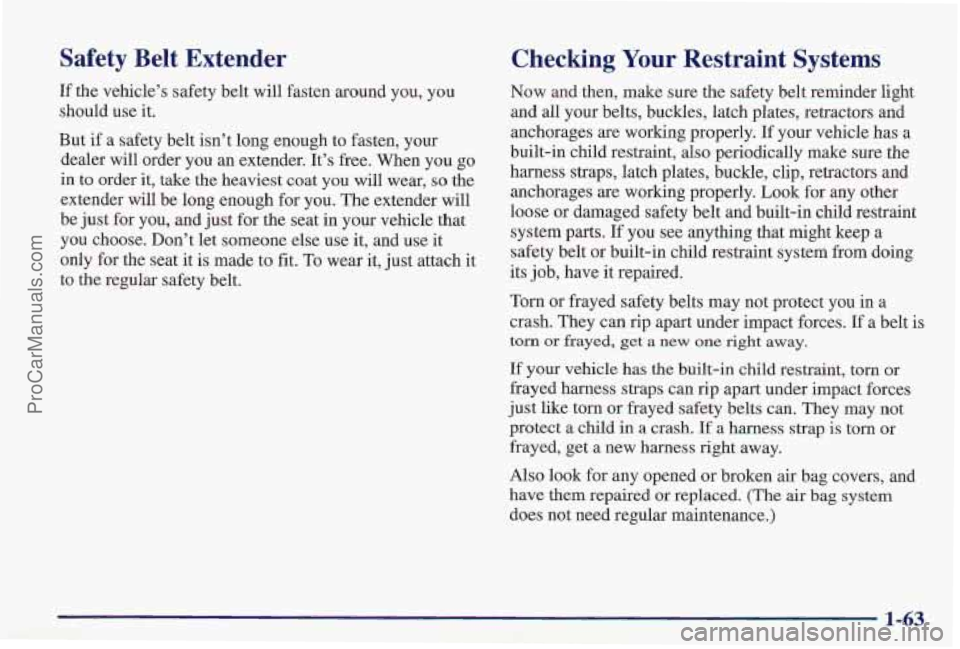
Safety Belt Extender
If the vehicle’s safety belt will fasten around you, you
should use it.
But
if a safety belt isn’t long enough to fasten, your
dealer will order you an extender. It’s free. When you
go
in to order it, take the heaviest coat you will wear, so the
extender will be long enough for you. The extender will
be just for you, and just for the seat in your vehicle that
you choose. Don’t let someone else use it, and use it
only for the seat it is made to fit. To wear it, just attach it
to the regular safety belt.
Checking Your Restraint Systems
Now and then, make sure the safety belt reminder light
and all your belts, buckles, latch plates, retractors and
anchorages are working properly.
If your vehicle has a
built-in child restraint, also periodically make sure the
harness straps, latch plates, buckle, clip, retractors and
anchorages are working properly.
Look for any other
loose or damaged safety belt and built-in child restraint
system parts. If you see anything that might keep a
safety belt or built-in child restraint system from doing
its job, have it repaired.
Torn or frayed safety belts may not protect you in a
crash. They can rip apart under impact forces.
If a belt is
torn or frayed, get a new one right away.
If your vehicle has the built-in child restraint, torn or
frayed harness straps can rip apart under impact forces
just like torn or frayed safety belts can. They may not
protect a child in a crash.
If a harness strap is torn or
frayed, get a new harness right away.
Also look for any opened or broken air bag covers, and
have them repaired or replaced.
(The air bag system
does not need regular maintenance.)
1-63
ProCarManuals.com
Page 72 of 419
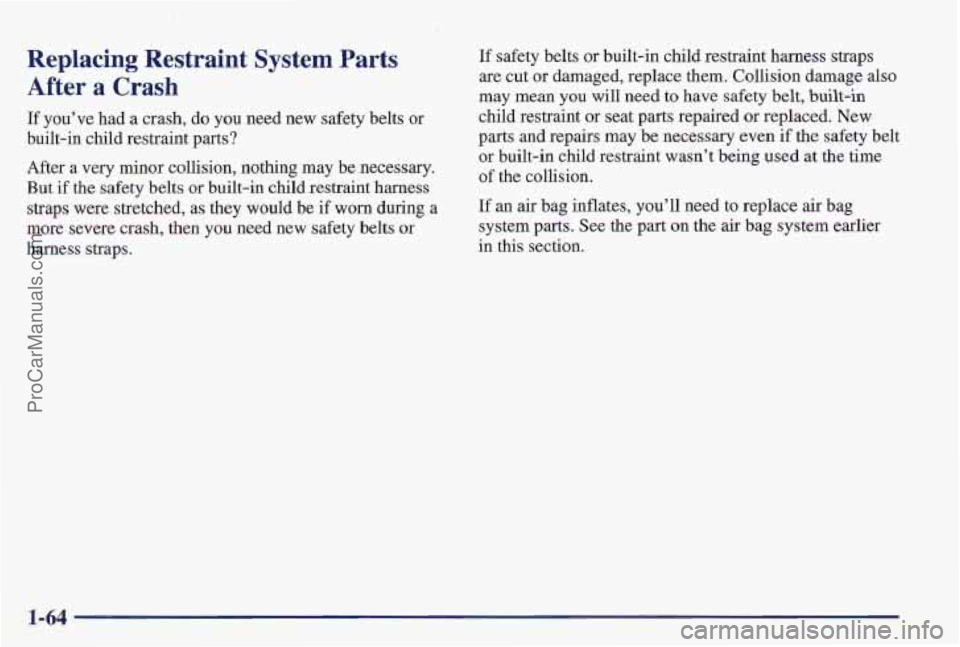
Replacing Restraint System Parts
After a Crash
If you’ve had a crash, do you need new safety belts or
built-in child restraint parts?
After a very minor collision, nothing may be necessary.
But if the safety belts
or built-in child restraint harness
straps were stretched,
as they would be if worn during a
more severe crash, then you need new safety belts or
harness
straps.
If safety belts or built-in child restraint harness straps
are cut
or darnaged, replace them. Collision damage also
may mean you will need to have safety belt, built-in
child restraint or seat parts repaired or replaced. New
parts and repairs may be necessary even if the safety belt
or built-in child restraint wasn’t beine used at the time
of the collision.
If an air bag inflates, you’ll need to replace ais bag
system parts. See the part on the air bag system earlier
in this section.
ProCarManuals.com
Page 73 of 419

b NOTES
1-65
ProCarManuals.com
Page 74 of 419

b%) NOTES
1-66
ProCarManuals.com
Page 75 of 419
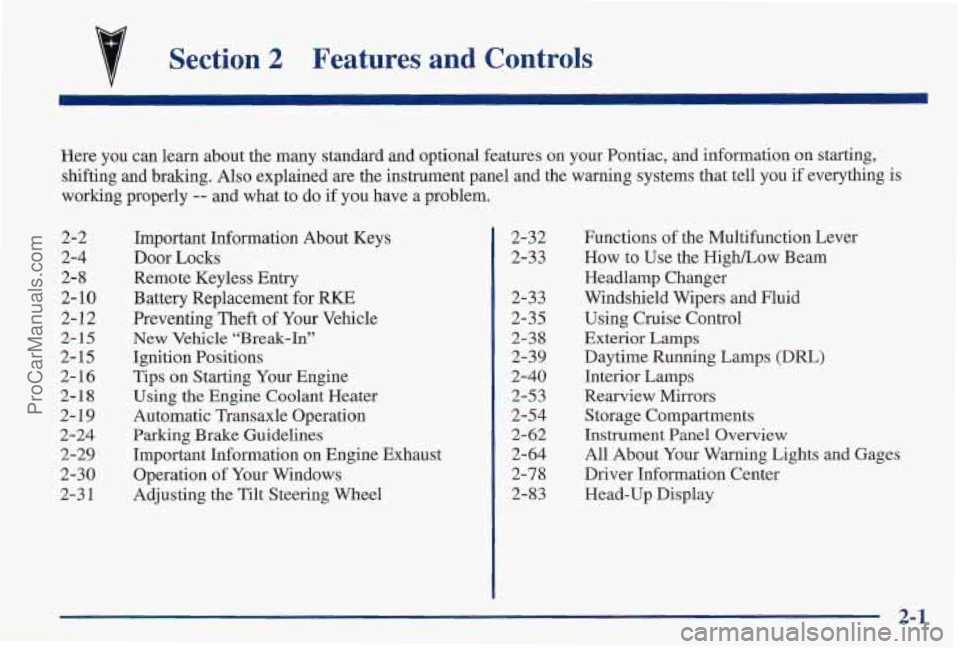
v Section 2 Features and Controls
Here you can learn about the many standard and optional features on your Pontiac, and information on starting,
shifting and braking. Also explained are the instrument panel and the warning systems that tell you if everything is
working properly
-- and what to do if you have a problem.
2-2
2-4
2-8
2- 10
2-12
2-15
2-15
2- 16
2-18
2-19
2-24
2-29
2-30
2-3 1
Important Information About Keys
Door Locks
Remote Keyless Entry Battery Replacement for RKE
Preventing Theft
of Your Vehicle
New Vehicle “Break-In”
Ignition Positions
Tips on Starting Your Engine
Using the Engine Coolant Heater
Automatic Transaxle Operation
Parking Brake Guidelines
Important Information on Engine Exhaust
Operation of Your Windows
Adjusting the Tilt Steering Wheel 2-32
2-33
2-33
2-35
2-3 8
2-39
2-40
2-5 3
2-54
2-62
2-64
2-78
2-83
Functions of the Multifunction Lever
How to Use the HighLow Beam
Headlamp Changer
Windshield Wipers and Fluid
Using Cruise Control
Exterior Lamps
Daytime Running Lamps
(DRL)
Interior Lamps
Rearview Mirrors
Storage Compartments
Instrument Panel Overview
All About Your Warning Lights and Gages
Driver Information Center
Head-Up Display
2-1
ProCarManuals.com
Page 76 of 419
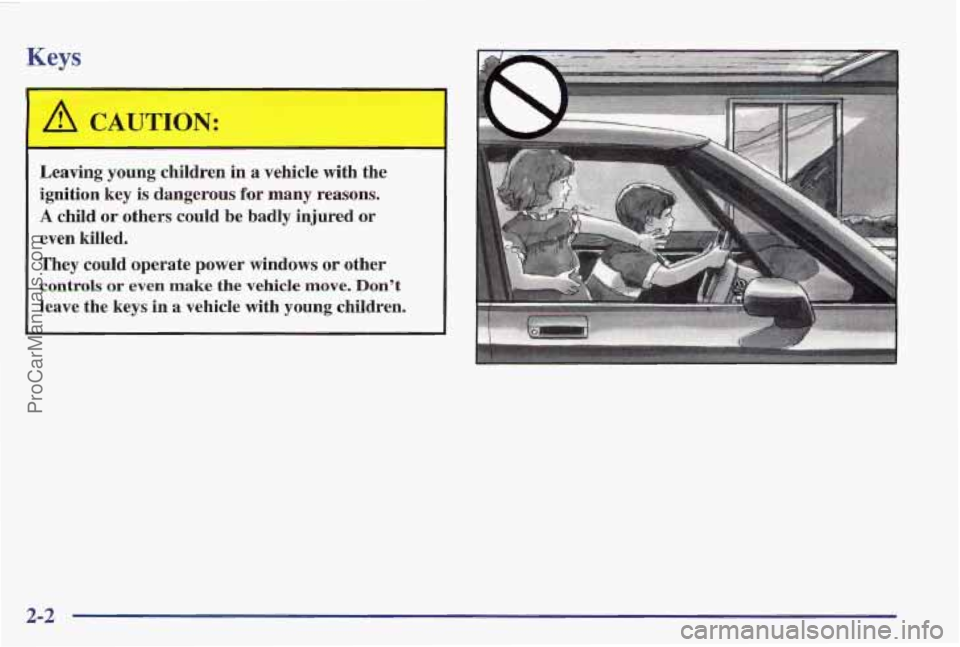
Keys
Leaving young children in a vehicle with the
ignition key
is dangerous for many reasons.
A child or others could be badly injured or
even killed.
They could operate power windows or other
controls or even make the vehicle move. Don’t
leave the keys in a vehicle with young children.
2-2
ProCarManuals.com
Page 77 of 419
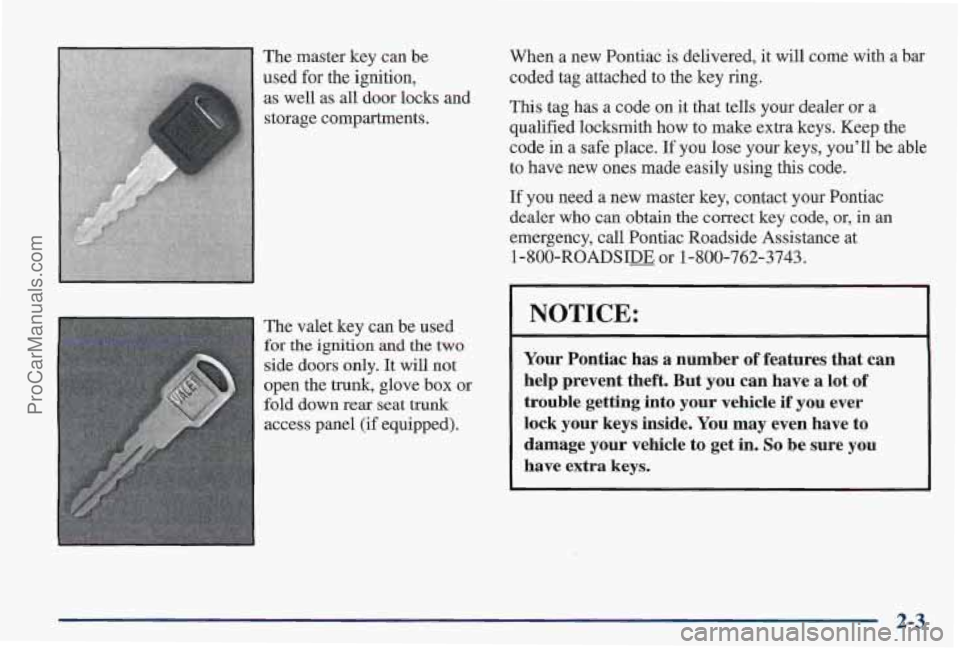
The master key can be
used for the ignition,
as well as all door locks and
storage compartments.
The valet key can be used
for the ignition and the two
side doors only. It will not
open the trunk, glove box or
fold down
rear seat trunk
access panel (if equipped). When
a new Pontiac is delivered, it will come with a bar
coded tag attached to the key ring.
This tag has a code
on it that tells your dealer or a
qualified locksmith how
to make extra keys. Keep the
code in a safe place. If you lose your keys, you’ll be able
to have new ones made easily using this code.
If you need a new master key, contact your Pontiac
dealer who can obtain the correct key code,
or, in an
emergency, call Pontiac Roadside Assistance at
1-800-ROADSIB or 1-800-762-3743.
I I
I NOTICE: I
Your Pontiac has a number of features that can
help prevent theft. But
you can have a lot of
trouble getting into your vehicle if you ever
lock your
keys inside. You may even have to
damage your vehicle to get in.
So be sure you
have extra keys.
2-3
ProCarManuals.com
Page 78 of 419
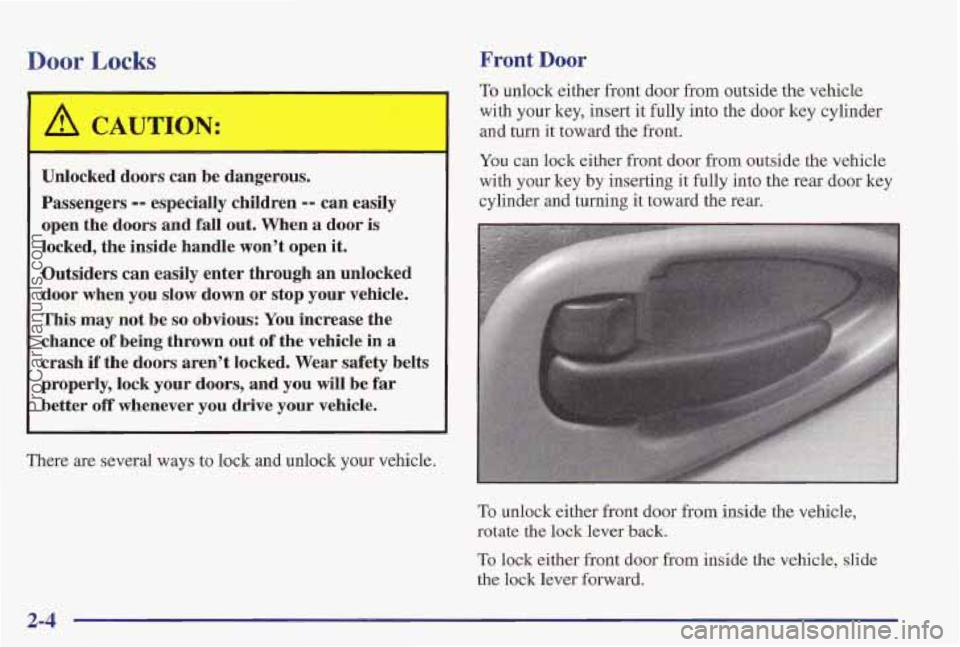
Door Locks Front Door
Unlocked doors can be dangerous.
Passengers
-- especially children -- can easily
open the doors and fall
out. When a door is
locked, the inside handle won’t open
it.
Outsiders can easily enter through an unlocked
door when you slow down or stop your vehicle.
This may not
be so obvious: You increase the
chance of being thrown
out of the vehicle in a
crash if the doors aren’t locked. Wear safety belt:
properly, lock your
doors, and you will be far
better off whenever you drive your vehicle.
To unlock either front door from outside the vehicle
with your key, insert it fully into the door key cylinder
and turn it toward the front.
You can lock either front door from outside the vehicle
with your key by inserting it fully into the rear door key
cylinder and turning it toward the rear.
There are several ways to lock and unlock your vehicle.
To unlock either front door from inside the vehicle,
rotate the lock
lever back.
To lock either front door from inside the vehicle, slide
the
lock lever forward.
2-4
ProCarManuals.com
Page 79 of 419
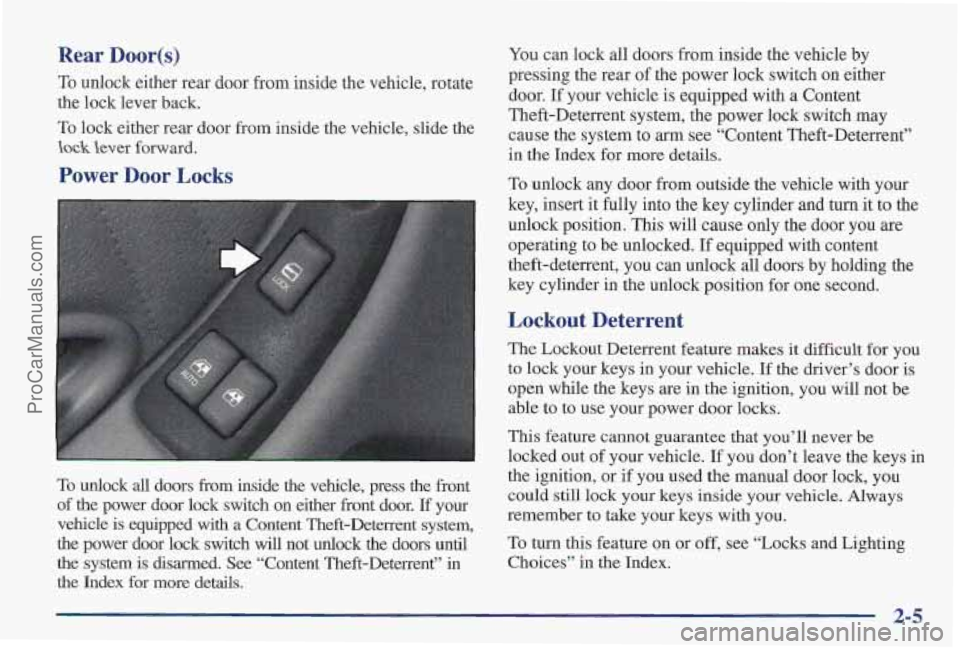
Rear Door(s)
To unlock either rear door from inside the vehicle, rotate
the lock lever back.
To lock either rear door from inside the vehicle, slide the
lock lever forward.
Power Door Locks
To unlock all doors from inside the vehicle, press the fiont
of
the power door lock switch on either front door. If your
vehicle is equipped with a Content Theft-Deterrent system,
the power door lock switch will not unlock
the doors until
the system
is disarmed. See “Content Theft-Deterrent” in
the Index for more details.
You can lock all doors from inside the vehicle by
pressing the rear
of the power lock switch on either
door. If your vehicle is equipped with
a Content
Theft-Deterrent system, the power lock switch may
cause the system
to arm see “Content Theft-Deterrent”
in the Index for more details.
To unlock any door from outside the vehicle with your
key, insert it fully into the key cylinder and turn it to the
unlock position. This will cause only the door you
are
operating to be unlocked. If equipped with content
theft-deterrent, you can unlock all doors by holding the
key cylinder in the unlock position for one second.
Lockout Deterrent
The Lockout Deterrent feature makes it difficult for you
to lock your keys in your vehicle. If the driver’s door is
open while the keys are in the ignition, you will not be
able to to use your power door locks.
This feature cannot guarantee that you’ll never be
locked out of your vehicle.
If you don’t leave the keys in
the ignition, or if you used the manual door lock, you
could still lock your keys inside your vehicle. Always
remember to take your keys with you.
To turn this feature on or off, see “Locks and Lighting
Choices” in the Index.
2-5
ProCarManuals.com
Page 80 of 419
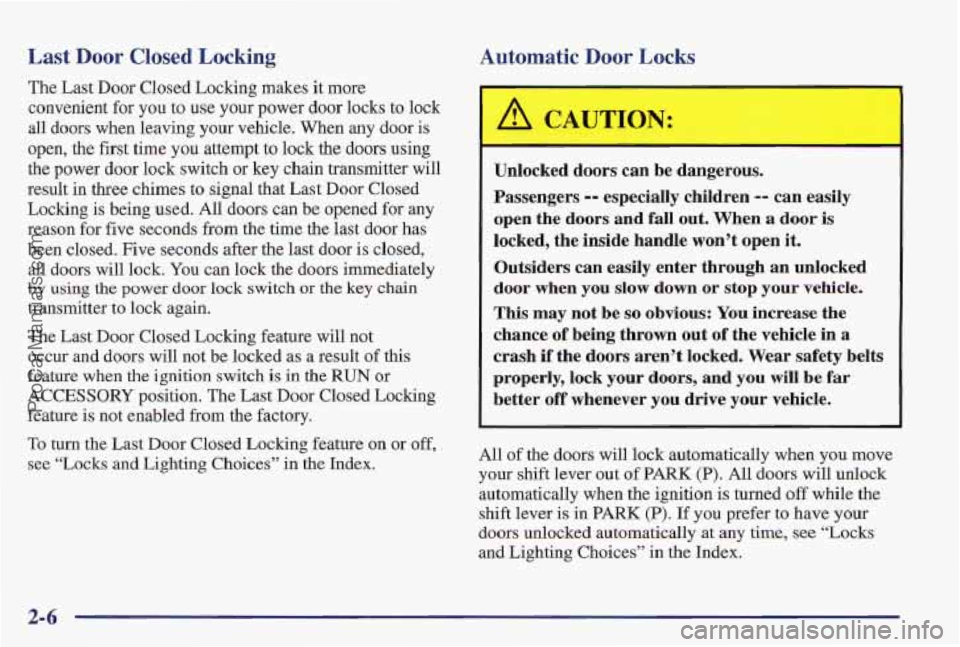
Last Door Closed Locking
The Last Door Closed Locking makes it more
convenient €or you to use your power door lo’cks to lock
all doors when leaving your vehicle. When any door
is
open, the first time you attempt to lock the doors using
the power
door lock switch or key chain transmitter will
result in three chimes to signal that Last
Door Closed
Locking is being used. All doors can be opened for any
reason for five seconds from the time the last door has
been closed. Five seconds after the last door is closed,
all doors will lock. You can lock the doors immediately
by using the power door lock switch or the key chain
transmitter
to lock again.
The Last Door Closed
Locking feature will not
occur and d’oors will not
be locked as a result of this
feature when
the ignition switch is in the RUN or
ACCESSORY position. The Last Door Closed Locking
feature
is not enabled from the factory.
Automatic Door Locks
I
Unlocked doors can be dangerous.
Passengers -- especially children -- can easily
open the doors and fall out. When
a door is
locked, the inside handle won’t open
it.
Outsiders can easily enter through an unlocked
door when you slow down or stop your vehicle.
This
may not be so obvious: You increase the
chance
of being thrown out of the vehicle in a
crash
if the doors aren’t locked. Wear safety belts
properly, lock your doors, and you will
be far
better off whenever you drive your vehicle.
To turn the Last Door Closed Locking feature on or off,
see “Locks and Lighting Choices” in the Index. All of the
doors will lock automatically when you move
your shift lever
out of PARK (P). All doors will. unl’ock
automatically when the ignition
is turned off while the
shift lever
is in PARK (P). If you prefer to have your
doors unlocked automatically at any time, see “Locks
and Lighting Choices” in the Index.
2-6
ProCarManuals.com